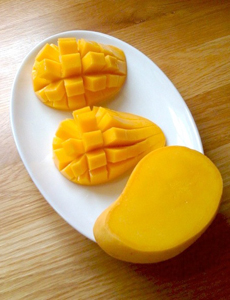TIP OF THE DAY: The Ataulfo Mango (Champagne Mango)
 The Ataulfo, or Champagne, mango. Photo courtesy ILoveMangoes.com. |
When you think of mangoes, you may think of the familiar reddish-green mangos and wonder about the petite golden-yellow ones that some people call baby mangoes.
They’re Ataulfo mangos from Mexico, also commonly called Champagne mangoes, and they’re in season now. Mango lovers prefer them to the more prevalent Tommy Atkins cultivar (the red-green ones in the photo below). Their buttery flesh is not fibrous, and their thin pit makes them easier to slice and dice than other varieties. The Ataulfo—it was found in a conventional mango grove owned by Mr. Ataulfo Morales—goes by several other names as well: Adaulfo, Adolfo, baby, honey, and yellow mango. It is closely related to the Alphonso variety popular in India. |
|
|
MANGO NUTRITION Mangoes deliver sumptuous tropical flavor with easy calories. Our favorite way to eat a mango is with a knife and fork, as a delicious fruit snack or dessert (note that the skin can cause stomach irritation, so should not be eaten). Second place goes to mango sorbet. But use mango however you would use peaches or pineapples—the two fruits to which mango’s flavor is compared. |
||
|
HOW TO SLICE A MANGO |
 The Tommy Atkins mango is the most commonly available in the U.S., due to its hardiness. Photo courtesy National Mango Board. |
|
|
Mangoes need to ripen in a warm room. To speed ripening, you can place them in a paper bag. Color is not the best way to determine ripeness. Instead, touch and smell: A ripe mango will have a fruity aroma and the flesh will yield to gentle pressure. Unripe mangoes have no scent. Ripe mangoes can be kept in the fridge for up to 2 weeks. The peeled flesh can be dried, frozen, puréed, or stewed. Ataulfo mangos have only recently gained popularity in the United States, but have been a major crop in Mexico for decades. In season between March and September, they are the second-most popular variety of mango sold in the U.S., behind the Tommy Atkins cultivar. And here’s the big tip of the day: The most prevalent mango, the Tommy Atkins, is not considered to be the choicest mango in terms of sweetness and flavor. Retailers prefer it for its very long shelf life and ability to be handled with little or no bruising, which is why it’s the mango offered first and foremost. [Source: Wikipedia] So go for the gold: Bring home some Ataulfos and taste the difference. The other less common mango varieties found in the U.S. include the Haden and Kent, which appear along with the Ataulfo and the Tommy Atkins in spring and summer; and the orange and green Keitt from Australia, which comes from Australia in the fall (and has a lemony note to the flesh). Many people attest that mangoes taste best right off the tree, fresh and succulent. So if you’re in Florida, Mexico, or another mango haven, see if you can seek out the experience, called by one expert “a taste experience you’ll never forget.” CHECK OUT WHAT’S HAPPENING ON OUR HOME PAGE, THENIBBLE.COM. |
||


